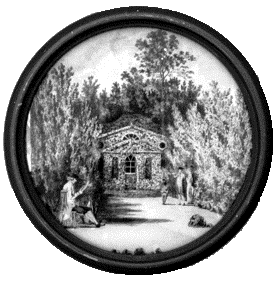Scott's Grotto facts for kids
Scott's Grotto is a super cool underground cave system in Ware, Hertfordshire, in the United Kingdom. It's known as a "shell grotto" because its walls are covered in thousands of shells, stones, and even fossils! It's a very special place, listed as a Grade I building, which means it's super important historically. With six different rooms, it's the biggest shell grotto you can find in the UK.
What is Scott's Grotto?
This amazing grotto is built into the side of a hill. It has an entrance hall and six unique rooms that stretch over 65 feet (about 20 meters) into the hill. Some parts go as deep as 30 feet (about 9 meters) underground!
- Underground Rooms: The grotto has different rooms connected by secret passages. There are also air shafts and light wells to bring in fresh air and a bit of sunlight.
- Amazing Decorations: The walls of these rooms are covered with beautiful shells, shiny stones like flint, old fossils, and colorful pieces of glass. It's like walking into a sparkling, hidden world!
- Room Names: Back in 1900, a map of the grotto showed names for the rooms. There's a big round room called the "Council Chamber" with a cool domed roof. Other rooms include the "Committee Room No 2," the "Refreshments Room," the "Consulting Room," another "Committee Room," and the "Robing Room."
Who Built This Amazing Place?
Scott's Grotto was once part of the garden of a house called Amwell House. It was built by a man named John Scott. He was a poet and inherited Amwell House in 1768. It probably took him several years to finish building this incredible grotto.
- More Garden Fun: John Scott loved making his garden special. Besides the grotto, he also built other cool things, like an octagonal (eight-sided) gazebo on the hill above.
- A Popular Spot: People loved visiting the grotto! John Scott even kept a book where he wrote down the names of visitors. Between 1779 and 1787, over 3,000 people came to see it. Even a famous writer named Samuel Johnson visited in 1773 and called it a "fairy hall."
Saving the Grotto
After John Scott passed away, his daughter Marie inherited the house and garden. Later, in the 1960s and 1970s, new houses were built nearby. The builders originally wanted to knock down the grotto, but the local council stepped in to protect it!
- Becoming Protected: The grotto became a protected historical building in 1950. This helped save it from being destroyed.
- Restoration: In 1974, the local council took over the grotto. Then, from 1990 to 1991, a group called the Ware Society worked hard to restore it. They even rebuilt the entrance hall that had been taken down earlier. As a cool historical touch, a small piece of the Berlin Wall was put into the entrance hall during this restoration!
- Managed Today: Today, the grotto and its gardens are looked after by the Scott's Grotto Trust. They make sure this amazing historical site stays safe for everyone to enjoy.



